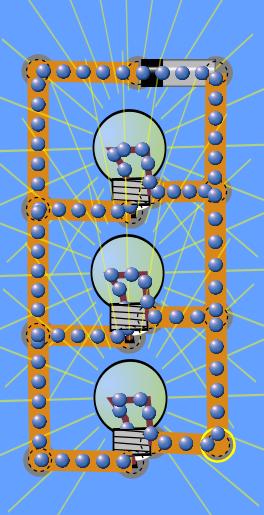Parallel circuit: Difference between revisions
J.williams (talk | contribs) m (1 revision imported) |
No edit summary |
||
| Line 1: | Line 1: | ||
[[Category:Done | [[Category:Done 2018-04-30]] | ||
[[File:Parallel circuit example.jpg|framed|right|Figure 1. An example of a parallel circuit generated with a PhET.<ref name=E>http://phet.colorado.edu/en/simulation/circuit-construction-kit-dc-virtual-lab</ref> Each of the three light bulbs are in parallel.]] | [[File:Parallel circuit example.jpg|framed|right|Figure 1. An example of a parallel circuit generated with a PhET.<ref name=E>http://phet.colorado.edu/en/simulation/circuit-construction-kit-dc-virtual-lab</ref> Each of the three light bulbs are in parallel.]] | ||
<onlyinclude>Many electrical components in an [[electric circuit]] have two leads (ends). As a result, they can be connected in one of two ways, in series (one electrical lead is touching the other), or in parallel (both leads are touching). | <onlyinclude>Many electrical components in an [[electric circuit]] have two leads (ends). As a result, they can be connected in one of two ways, in series (one electrical lead is touching the other), or in parallel (both leads are touching). | ||
'''Parallel circuits''' provide more than one current path between any two points.</onlyinclude> These circuits have the advantage of making each component effectively invisible to the other components. This makes each load (electrical component, like a hairdryer) independent. The | '''Parallel circuits''' provide more than one current path between any two points.</onlyinclude> These circuits have the advantage of making each component effectively invisible to the other components. This makes each load (electrical component, like a hairdryer) independent. The [[electric current]] flowing through each component is based only on the [[resistance]] of that component, not on the other components. | ||
The electric [[outlet]]s in a house are all parallel. This means that with ideal electrical circuits, turning on a television set usually has no effect on electric lights in the same room. Careful observation can detect lights dimming momentarily when an additional component is turned on. Refrigerators often cause kitchen lights to dim slightly. | The electric [[outlet]]s in a house are all parallel. This means that with ideal electrical circuits, turning on a television set usually has no effect on electric lights in the same room. Careful observation can detect lights dimming momentarily when an additional component is turned on. Refrigerators often cause kitchen lights to dim slightly. | ||
| Line 10: | Line 10: | ||
The circuit in Figure 1 is in parallel and the lightbulbs act as the loads. Each component has different current running through it. The voltage across each component is equivalent to the voltage across all the others.<ref name=A>R.T. Paynter, “Basic Electric Components and Meters,” in ''Introduction to Electricity'', 1st ed. NJ: Prentice Hall, 2011, ch. 6, sec. 6.1, pp. 228-240.</ref> The total resistance of a parallel circuit must be less than the individual resistance of any branch resistance value in the circuit; this can be explained by [[Ohm's law]]. | The circuit in Figure 1 is in parallel and the lightbulbs act as the loads. Each component has different current running through it. The voltage across each component is equivalent to the voltage across all the others.<ref name=A>R.T. Paynter, “Basic Electric Components and Meters,” in ''Introduction to Electricity'', 1st ed. NJ: Prentice Hall, 2011, ch. 6, sec. 6.1, pp. 228-240.</ref> The total resistance of a parallel circuit must be less than the individual resistance of any branch resistance value in the circuit; this can be explained by [[Ohm's law]]. | ||
== For Further Reading == | |||
For further information please see the related pages below: | |||
*[[Series circuit]] | |||
*[[Electric circuit]] | |||
*[[Conductor]] | |||
*[[Battery]] | |||
*[[Electric generator]] | |||
* Or explore a [[Special:Random| random page!]] | |||
==References== | ==References== | ||
{{reflist}} | {{reflist}} | ||
[[Category:Uploaded]] | [[Category:Uploaded]] | ||
Revision as of 21:24, 9 May 2018

Many electrical components in an electric circuit have two leads (ends). As a result, they can be connected in one of two ways, in series (one electrical lead is touching the other), or in parallel (both leads are touching).
Parallel circuits provide more than one current path between any two points. These circuits have the advantage of making each component effectively invisible to the other components. This makes each load (electrical component, like a hairdryer) independent. The electric current flowing through each component is based only on the resistance of that component, not on the other components.
The electric outlets in a house are all parallel. This means that with ideal electrical circuits, turning on a television set usually has no effect on electric lights in the same room. Careful observation can detect lights dimming momentarily when an additional component is turned on. Refrigerators often cause kitchen lights to dim slightly.
Circuit breakers and fuses have different parallel circuits. That means that if one circuit gets overloaded (tripping the circuit breaker or blowing the fuse), it won't have any effect on the other circuits. The circuit breaker or fuse itself is in series with the rest of the circuit though. Likewise, different houses in a neighbourhood are parallel. A neighbour cooking dinner has no effect on someone ironing in a different house on a different circuit.
The circuit in Figure 1 is in parallel and the lightbulbs act as the loads. Each component has different current running through it. The voltage across each component is equivalent to the voltage across all the others.[2] The total resistance of a parallel circuit must be less than the individual resistance of any branch resistance value in the circuit; this can be explained by Ohm's law.
For Further Reading
For further information please see the related pages below:
References
- ↑ http://phet.colorado.edu/en/simulation/circuit-construction-kit-dc-virtual-lab
- ↑ R.T. Paynter, “Basic Electric Components and Meters,” in Introduction to Electricity, 1st ed. NJ: Prentice Hall, 2011, ch. 6, sec. 6.1, pp. 228-240.

